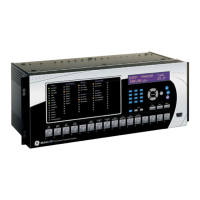5-18 T60 Transformer Protection System GE Multilin
5.2 PRODUCT SETUP 5 SETTINGS
5
c) NETWORK
PATH: SETTINGS PRODUCT SETUP COMMUNICATIONS NETWORK
These messages appear only if the T60 is ordered with an Ethernet card.
The IP addresses are used with the DNP, Modbus/TCP, IEC 61580, IEC 60870-5-104, TFTP, and HTTP protocols. The
NSAP address is used with the IEC 61850 protocol over the OSI (CLNP/TP4) stack only. Each network protocol has a set-
ting for the TCP/UDP port number. These settings are used only in advanced network configurations and should normally
be left at their default values, but may be changed if required (for example, to allow access to multiple UR-series relays
behind a router). By setting a different
TCP/UDP PORT NUMBER for a given protocol on each UR-series relay, the router can
map the relays to the same external IP address. The client software (EnerVista UR Setup, for example) must be configured
to use the correct port number if these settings are used.
When the NSAP address, any TCP/UDP port number, or any user map setting (when used with DNP) is changed, it
will not become active until power to the relay has been cycled (off-on).
d) MODBUS PROTOCOL
PATH: SETTINGS PRODUCT SETUP COMMUNICATIONS MODBUS PROTOCOL
The serial communication ports utilize the Modbus protocol, unless the port is configured for DNP or IEC 60870-5-104
operation. This allows the EnerVista UR Setup software to be used on the port. The UR operates as a Modbus slave device
only.
When using Modbus protocol on the RS232 port, the T60 responds regardless of the
MODBUS SLAVE ADDRESS pro-
grammed. For the RS485 port, each device on the serial bus must have a unique slave address from 1 to 254. Address 0
and addresses from 248 and up are reserved by the Modbus protocol specification, and so their use here is not recom-
mended. Address 0 is the broadcast address that all Modbus slave devices listen to. When
MODBUS SLAVE ADDRESS is set
to 0, the UR accepts broadcast messages, but in compliance with protocol specifications for broadcast messages, never
replies. Addresses do not have to be sequential, but no two devices can have the same address or conflicts resulting in
errors occur. Generally, each device added to the link should use the next higher address starting at 1. When using Modbus
TCP/IP, the client must use the programmed
MODBUS SLAVE ADDRESS value in the Unit Identifier field. See Appendix B for
more information on the Modbus protocol.
Modbus over TCP/IP can also be used on any of the Ethernet ports. The listening TCP port 502 is reserved for Modbus
communications, and only in exceptional cases when
MODBUS TCP PORT NUMBER is set to any other port. The MODBUS TCP
PORT NUMBER
setting sets the TCP port used by Modbus on Ethernet. A MODBUS TCP PORT NUMBER of 0 disables Modbus
over TCP/IP, meaning closes the Modbus TCP port. When it is set to 0, use the front panel or serial port to communicate
with the relay.
NETWORK
IP ADDRESS:
0.0.0.0
Range: Standard IP address format
Not shown if CPU Type E is ordered.
MESSAGE
SUBNET IP MASK:
0.0.0.0
Range: Standard IP address format
Not shown if CPU Type E is ordered.
MESSAGE
GATEWAY IP ADDRESS:
0.0.0.0
Range: Standard IP address format
Not shown if CPU Type E is ordered.
MESSAGE
OSI NETWORK
ADDRESS (NSAP)
Range: Select to enter the OSI NETWORK ADDRESS.
Not shown if CPU Type E is ordered.
MESSAGE
ETHERNET OPERATION
MODE: Full-Duplex
Range: Half-Duplex, Full-Duplex
Not shown if CPU Type E or N is ordered.
MODBUS PROTOCOL
MODBUS SLAVE
ADDRESS: 254
Range: 1 to 254 in steps of 1
MESSAGE
MODBUS TCP PORT
NUMBER: 502
Range: 1 to 65535 in steps of 1

